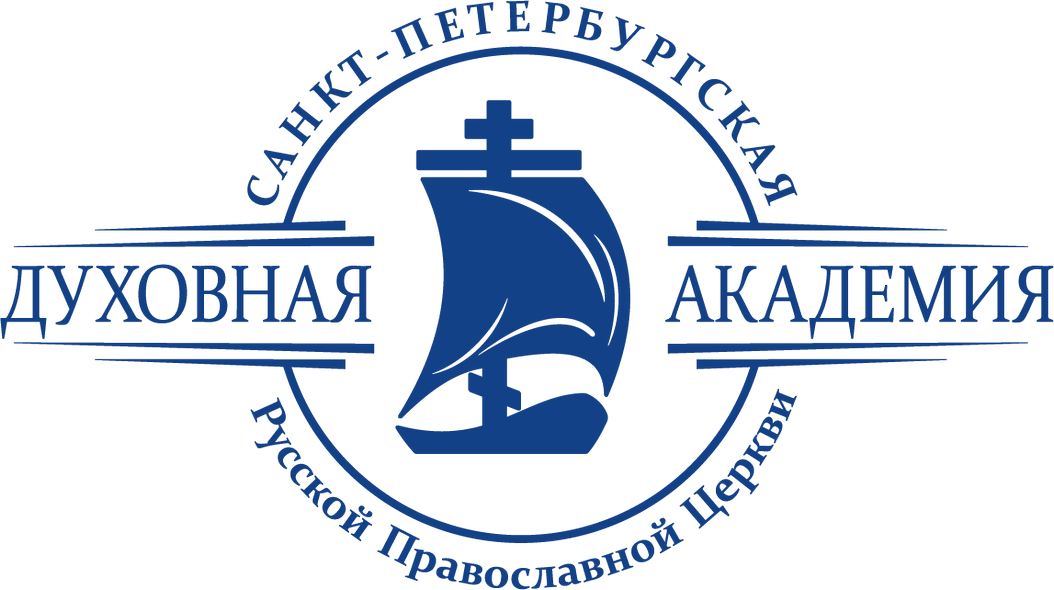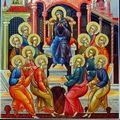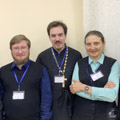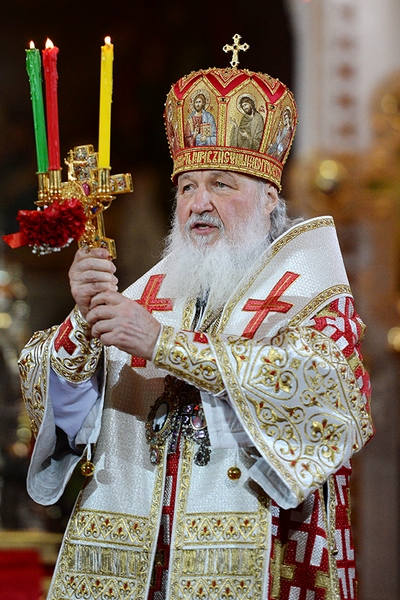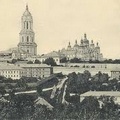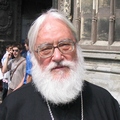
‘The Kingdom of heaven suffers violence….’
‘The kingdom of heaven’, says Christ, ‘suffers violence, and it is the violent who take it by force’ (Matthew 11 : 12). These are words that apply in a particularly direct way to the life of the solitary. We human beings are d by God in His own image and likeness (Genesis 1 : 26-27. We are d, that is to say, in the image of the Holy Trinity, according to the likeness of a God who is not only one but one-in-three, of a God who is mutual love. We are ikons of a God whose being is relational being, a God who is social and communal, albeit in a manner infinitely transcending all human society and community. Humans, therefore, fashioned as they are in the image of this Triune Deity, are d for relationship and for mutual love and service. They are d as members of a single body, and it is precisely this interdependence that is reaffirmed in the life of the Church (1 Corinthians 12: 12-27; Ephesians 4: 25). The very word for ‘person’ in the Greek language, prosopon, underlines the same point; for it means literally ‘face’ or ‘countenance’. I am not truly a person unless I face others, looking into their eyes and allowing them to look into mine.
If all this is true, does it not follow that the solitary life contradicts what it means to be a person in the Trinitarian divine image? Is not life in solitude an act of violence against the relational character of our human nature? This is something that especially disturbs St Basil the Great. ‘Who does not know’, he protests, ‘that man is a tame and sociable animal, not solitary and wild?’ For ‘solitary’ Basil uses here the word monastikon, meaning ‘monastic’. ‘Nothing’, he continues, ‘is so characteristic of our nature as to associate with one another, to need one another, and to love our own kind.’ What disturbs Basil is the fact that the solitary lacks the opportunity to display towards others the practical compassion that is fundamental to our humanness. ‘Whose feet will you wash,’ Basil asks, ‘whom will you look after, how can you be last of all, if you live by yourself?’
It should not be concluded, Basil’s words, that he was opposed on principle to the solitary life. On the contrary, according to St Gregory of Nazianzos, Basil strove to reconcile and unite the communal and the eremitic life by founding cells for anchorites not far his cenobitic houses. And here, indeed, we may find the beginnings of an answer to the difficulties that Basil raises. Solitude and communion, it may be argued, are not mutually exclusive. They are interdependent and complementary. This is a truth that Cicero emphasizes when he speaks of himself as ‘never less alone that when he is alone’ (nec minus solum quam cum solus esset). A person, in other words, may be alone in the sense that he is not in the immediate company of others; and yet, if he lives an intense and creative life of the Spirit, in the depths of himself he discovers an unbroken bond of communion with others. Seclusion does not necessarily signify isolation, nor does solitude imply loneliness and vacancy. Our fellow humans may be physically absent, but they are spiritually present. Communion can exist on many different levels. the Christian desert, Evagrios of Pontos makes the same point when he says that the monachos – by which he means perhaps not just the monk but the solitary – is ‘separated all and united to all’. This describes exactly the situation of anchorite, whether man or woman. She or he is ‘separated all’ externally, in spatial or topographical terms, but inwardly and spiritually he or she is united to all through prayer.
The hermit and the main monastery
Let us explore two ways in which this interaction between solitude and communion is worked out in practice. First, let us consider more fully the situation indicated by Basil, with solitaries living on the margin of a cenobitic community and in dependence upon it. Secondly, let us examine the way in which the cenobium acts as a preparation for the solitary life.
Two leading monasteries of the middle Byzantine era—the Great Lavra on Mount Athos, founded around 963, and St John the Theologian on Patmos, founded around 1088—in their typika legislate for the kind of link that Basil envisages between the cenobium and the solitary life. At the Great Lavra, St Athanasios lays down that, among the 120 monks comprising the community, not more than five at any one time shall be allowed to live outside the monastery as solitaries. These ‘kelliots’, as they are termed, receive their food the monastery. Each of them may have one disciple living with him; thus their solitude is not in fact total. The ‘kelliots’ continue to owe obedience to the abbot. With the abbot’s blessing, a monk may also live enclosed within his own cell inside the monastery walls.
The arrangements made at Patmos by St Christodoulos are similar. Not more than twelve solitaries, at any one time, are allowed to live outside the main monastery. They are to return to the monastery each Saturday, remaining for the vigil service that night and attending the Sunday morning Liturgy. Then they return to their hermitages on Sunday afternoon with sufficient food to last them through the week. They are also to come to the monastery on major feasts. While in the monastery the solitaries eat at the common table, but they are not permitted to speak to anyone except the abbot. Equally they are not to speak with others when living in their hermitages during the weak. On weekdays at their hermitages they are to have one meal a day, after the Ninth Hour, and are to eat only uncooked food. The solitaries remain under strict obedience to the abbot; if they show signs of self-will and insubordination, they will be at once recalled to live inside the monastery.
These two examples show how the arrangement envisaged by Basil – solitaries living in close proximity to a cenobitic monastery – might be carried out in practice. What is particularly significant, more especially in the case of Patmos, is the way in which the solitaries continue to maintain a close link with the monastery, revisiting it each weekend and remaining firmly under obedience to the abbot. Today there are no solitaries on Patmos, while on the Holy Mountain the situation is considerably d that laid down by Athanasios. All solitaries on Athos, it is true, are in principle dependent on one of the main monasteries, since the entire Athonite territory is divided up between the twenty ‘ruling’ houses. But in practice the hermit’s bond with the main monastery is unlikely to be very close. Certainly, the hermit may sometimes visit the main monastery, but probably he will not do so as often as each weekend. Usually he does not receive regular supplies of food the monastery, and in most instances he is not under close obedience to the abbot, although he may have a spiritual father – perhaps another hermit – who provides him with personal guidance.
Hermits on Athos live in a privileged and protected environment. For solitaries outside the Holy Mountain, to live within the grounds of an established cenobitic house offers obvious advantages. They can receive supplies the main monastery, without having to go out to a nearby town or village to do their shopping, and the monastery can protect them unwelcome visitors. In return, and much more importantly, the hidden presence of the nearby hermits will deepen and enrich the daily prayer of the cenobitic monks.
‘First learn to live with others….’
In the second place, the interdependence between life in community and life in solitude is evident in the way by the former acts as a preparation for the latter. As Abba Loukios says in the Sayings of the Desert Fathers, ‘Unless you first learn to live with others, you will not be able to live as you should in solitude.’ The future hermit needs first to be tried and tested by the experience of life in the cenobium.
This pattern, with the community serving as a preparation for solitude, is clearly evident in Palestinian monasticism during the fifth and sixth centuries. When St Sabas, as a young man aged eighteen, seeks admission to the semi-eremitic lavra of St Efthymios, the latter does not allow him to remain there but sends him to the nearby cenobium of Theoktistos. ‘My child,’ says Efthymios, ‘it is not right for you to stay in a lavra, for you are still young; it is better for the young in a cenobium.’ After twelve years of cenobitic life, Sabas is allowed to move into a cave near the monastery, he spends five days of each week in solitude, returning to the monastery for Saturday and Sunday. Then, after five more years he withdraws into the utter desert, meeting no one and living on wild plants. When Sabas becomes head of his own community, he follows the practice of Efthymios. He does not admit young applicants immediately to the semi-eremitic lavra under his direction but sends them to a special cenobium established for novices. After being tested in the common life, they may then be allowed to have a cell on their own in the lavra. Sabas tells John the Hesychast, ‘Just as the blossom precedes the fruit, the cenobitic life precedes the anachoretic.’
The Palestinian pattern is enshrined in Byzantine canonical legislation. Canon 41 of the Council in Trullo (AD 692) specifies that prospective hermits are to spend at least three years in a cenobium under obedience to the abbot. They are then to be examined by the diocesan bishop, after which they spend a further preparatory year in the cenobium. ‘When these four years have elapsed,’ states the canon, ‘if they persist in their intention they are then to be enclosed. Thereafter they shall not be allowed to leave their seclusion whenever they wish, unless it be for the common benefit or because they are forced to do so by some compelling reason endangering their life; and even then they shall first obtain the blessing of the local bishop.’
Today the provisions of Canon 41 in Trullo are not observed with any exactness. In the first place, many Orthodox monasteries are stavropegiac in status, and are therefore outside the jurisdiction of the local diocesan bishop. This is the situation in particular with the twenty ‘ruling’ monasteries on Mount Athos. In such a case, the decision to allow a monk to withdraw into solitude rests exclusively with the abbot of the monastery, acting in consultation with the council of senior brethren. Secondly, most monks live in community for considerably longer than four years before becoming solitaries. In nineteenth-century Russia, for example, St Seraphim of Sarov spent eight years as a novice and a further eight years as a professed monk in the main monastery, before he was given a blessing to move to a solitary cell in the forest four miles away.
Moreover, the act of eremitic withdrawal is in practice less irrevocable than Canon 41 in Tullo implies. It is not unusual for monks, after dwelling for some time in solitude, to seek readmittance to the cenobium, even though there is no ‘compelling reason endangering their life’ that obliges them to do so. Such a request to return to the main monastery is normally ed without great difficulty. A solitary may even be ordered by the monastic authorities to return to the cenobium, regardless of his own wishes. That was what happened to St Seraphim: after sixteen years in his forest retreat, his legs began to swell and he found it increasingly difficult to walk to the monastery for the Divine Liturgy and Holy Communion. So the abbot sent a peremptory message, requiring him to leave his hermitage and return to the monastery. He was then, however, allowed to live strictly enclosed in his cell, not attending services in the main church.
Allowance has also to be made for the fact that, in the monasticism of the Christian East, alongside the two extremes of the cenobium and the hermit life there exists a third, intermediate situation of the lavra or skete. This may be regarded as semi-cenobitic or semi-eremitic, according to the standpoint which it is viewed. This third way is to be found especially on Mount Athos, in the sketes of St Anna, Kapsokalyvia, Kerasia, and else. The modern skete is a monastic village, with a central church surrounded by a series of cottages, each of which is occupied by a small group of monks, usually between two and six in number. Often a postulant will go directly to live in a skete, without ever having passed through a fully organised cenobium.
The transition the semi-eremitic life of the skete to the fully eremitic life can often be made gradually, without any drastic transformation. Perhaps the other monks in a particular kellion will all have died, so that there remains no more than one survivor now dwelling on his own as de facto a solitary. natively, a monk may choose to leave a more central and populated kellion, and to take-up his dwelling alone in a more secluded cottage on the edge of the skete. On Athos there are also solitaries living in greater isolation at a distance any skete. Frequently a monk living in solitude is joined by one or more disciples, thus moving by degrees an eremitic to a semi-cenobitic way of life.
The existence in Eastern monasticism of the skete or lavra, alongside the full cenobium and the hermit’s cell, means that in practice the line of demarcation between life in community and the hermit life is somewhat blurred and indistinct. Between the two extremes of full community and full solitude there are various intervening possibilities, and in the course of his monastic career a monk may pass through several different situations. This variety is seen in Orthodoxy not as a defect but as an enrichment and a blessing. Community and solitude can overlap in a positive and life-giving manner.
The daily programme of a solitary
How should a solitary spend his time each day? Here again there is variety, and rightly so. As William Blake affirms, ‘One Law for the Lion & Ox is Oppression.’ St Christodoulos, as we noted, expects his hermits to live on uncooked vegetables and to eat only once a day, in the afternoon. A somewhat fuller description of a hermit’s daily programme and diet is provided by a fourteenth-century witness, St Gregory of Sinai. He divides the day into four periods of three hours each. Starting at dawn, the hesychastic solitary spends the first hour of the day on what Gregory terms the ‘remembrance of God through prayer and stillness of heart’ – that is, primarily the recitation of the Jesus Prayer. The second hour is given to reading, and the third to psalmodia or the recitation of the Ps. Gregory probably expects the solitary to know the Psalms by heart. The second and the third of the three-hour periods are devoted to the same three activities, in the same order. Then during the tenth hour of the day the solitary prepares and eats his meal. During the eleventh hour, if he wishes, he may take a short rest. During the twelfth hour he recites Vespers. Gregory does not mention the short Lesser Hours during the day, that is the Third, Sixth and Ninth Hours, each taking about ten minutes: presumably these are said respectively during the three periods assigned to Psalmody. There is also no reference to Compline, which is perhaps to be said around sunset, not long after Vespers.
For the night Gregory proposes three native programmes. ‘Beginners’ are to spend half the night awake and half asleep, with midnight forming the point of division; it does not matter which half of the night is used for vigil. ‘Those midway on the path’ (mesoi) are to spend the first two hours of the night awake, the next four asleep, and the remaining six awake. The ‘perfect’, adds Gregory with a dry touch of humour, have no need of sleep, and so can spend the whole night standing and keeping vigil. During the waking hours of the night the solitary recites Matins (Orthros), and presumably before that Mesonyktikon (the Midnight Office), and then at dawn the First Hour. The rest of the nightly vigil can be spent in further recitation of the Ps, in reading, and especially in the practice of the Jesus Prayer. It is significant that the solitary is not exempted reciting the Divine Office. But what is to happen if he cannot read? Gregory does not say; probably in that case he is expected instead to say the Jesus Prayer, and in fact precise rules exist, specifying how many ‘hundreds’ of the Jesus Prayer are to replace the different parts of the Divine Office.
As in the regulations for Patmos, Gregory expects the solitary to eat only once a day, after the Ninth Hour and before Vespers. He makes no mention of any collation earlier in the day. Presumably during Lent the solitary, following the normal Orthodox rules, would not eat until after Vespers. In the first week of Lent and in Holy Week he would doubtless observe a stricter fast, as is done by most monks in cenobia. Gregory allows the solitary to eat a pound of bread daily, and to drink two cups of wine and three of water. Otherwise his food is to consist of ‘whatever is at hand – not whatever your natural craving seeks, but what providence provides, to be eaten sparingly’. This presumably would include fresh vegetables, when available; for, at any rate on Mount Athos today, most hermits have a small garden.
Gregory of Sinai is not very explicit about the place of work in the solitary’s programme. He merely says, ‘There are three practices blessed by God: psalmody, prayer and reading – and handiwork for those weak in body.’ This suggests that a ‘strong’ solitary would not need to work, but this can hardly be Gregory’s intention; for, the fourth century onwards, it has been taken for ed in the Christian East that the monk should not beg for alms but should earn his own living. In common with St Paul, the monk says: ‘I worked with my own hands to support myself’. (Acts 20 : 34). ‘Handiwork’, in the case of a solitary, might mean simple manual labour, such as basket-making. Contemporary Athonite hermits often occupy themselves with icon-painting, wood-carving, the preparation of incense, or the making of prayer-ropes (komvoschoinia). The Psalms or the Jesus Prayer may be recited while performing manual labour. But when the solitary is attempting to say the Jesus Prayer with concentrated ‘stillness of heart’, he would not wish to combine it with any external activity.
Gregory does not raise the question of silence. Does the solitary sometimes receive visitors? Is he allowed to call on nearby hermits and to talk with them about spiritual questions? Christodoulos discourages such contacts. To judge, however, the Sayings of the Desert Fathers, most of the ‘old men’ in the Egyptian desert were eminently sociable; mutual visits between recluses were accepted as normal and even desirable. Such continues to be the practice on Athos today. But of course individual anchorites may feel the call, either temporarily or permanently, to enter into total silence. While in the forest, at one stage Seraphim of Sarov spoke to no one; he did not open the door to visitors, and if he met anyone on the woodland paths he lay on his face until they had gone away.
The programme outlined by Gregory of Sinai is unquestionably severe, although not inhuman. Later in the fourteenth century, St Kallistos and St Ignatios Xanthopoulos propose a somewhat easier regime. At sunset, the solitary is to say the Jesus Prayer for about an hour, and then to recite Compline, continuing with a further half-hour of the Jesus Prayer. Then, after a period of self-examination, he retires to rest, sleeping for about five or six hours, depending on the time of year. The remaining part of the night is devoted to the Jesus Prayer and to the Divine Office (Mesonyktikon, Orthros, the First Hour). The morning is to be spent on the Jesus Prayer and on reading, especially the Scriptures. The Lesser Hours are said at the appropriate times. When it is a fast day, the solitary eats once, at the ninth hour; on other days he may eat twice, the first meal being taken at mid-day. After the mid-day meal he may sleep for an hour, if it is summer and the days are long. In the afternoon he practices handiwork; reciting the Jesus Prayer as he does so. Vespers is said at the appropriate time, followed presumably by the second meal (if taken). Flexibility is allowed for those who find it difficult to say the Jesus Prayer for long periods.
Thus the Xanthopouloi, like Gregory of Sinai, expect the solitary to recite the Divine Office in full. The stipulations of the Xanthopouloi concerning food and sleep correspond more or less to what would be demanded a monk in a cenobium. Here, in the programme of the Xanthopouloi rather than in that of Gregory, is a pattern that might appropriately be followed by a solitary in the twenty-first century.
The Xanthopouloi emphasize the need for the solitary to read Holy Scripture, and this is a point frequently mentioned in other sources as well. It was the practice of Seraphim of Sarov, for example, while enclosed in his cell within the monastery, to read each week the Four Gospels in their entirety: Matthew on Monday, Mark on Tuesday, Luke on Wednesday, and John on Thursday; on the remaining days, the Acts and the Epistles. In this way the solitary life becomes par excellence an Evangelical and Scriptural vocation.
‘Contending with lions and tigers’
When it was said above that the regime proposed by the Xanthopouloi is ‘somewhat easier’, this is to be understood in relative terms; for, considered in itself, the solitary vocation is never easy. Comparing the communal and the solitary ways of life, Evagrios says that, when a monk dwells with others, the demons attack him indirectly, through the annoyances caused to him by his brethren and through the various tensions existing in the community. When, however, he goes out into the desert, the demons no longer use fellow humans as intermediaries but they attack him directly. However irritating our brethren may be, it is incomparably easier to put up with them than to encounter the demons face to face. Thus, just as the demons are more terrible then our fellow humans, so the solitary life is far harder than the communal. The saints of the Russian tradition confirm this. ‘Solitude demands the fortitude of an angel’, says St Nil Sorsky.
St Seraphim of Sarov, who knew at first hand the life of both the coenobite and the hermit, had no illusions which was the more exacting: ‘He was reluctant’, we are told, ‘to advise others to live in the desert. One who lives in the desert, he warned, must be like someone nailed to the cross; and he added that if, in the struggle against the enemy, monks in a monastery fought as though they contended with doves, the man in the desert had to fight as one contending with lions and tigers.’
‘Acquire inner peace….’
More needs to be said, before we close, about the difficulty raised at the outset. How are we to answer St Basil when he asks, ‘Whose feet will you wash … if you live alone?’ What service does the solitary render to the world at large? Is it not selfish and antisocial to withdraw into seclusion, turning our back (so it seems) on the distress and suffering of our fellow humans? This is a criticism of the solitary life that has often been made, alike in the past and more especially in our own time. How shall we respond?
It is of course possible to reply with Christ’s words, ‘When you pray, go into your room and shut the door, and pray to your Father who is in secret’ (Matthew 6 : 6). Christ himself regularly withdrew ‘to a deserted place’ in order to pray (Mark 1 : 35); Luke 4 : 42). But surely, when Christ says ‘shut the door’, he is speaking of something that we are to do time to time, on a temporary basis, before we return once more to the duties and demands of our daily life in society. He is not suggesting that we should keep the door permanently closed. He is simply stating that, in the life of every person committed to active social work, there needs to be a dimension of solitude.
What, then are we to say about those for whom the solitude is an enduring condition? Of all the possible answers to St Basil’s question, the best known to me is provided by St Seraphim. ‘Acquire inner peace,’ he says, ‘and thousands around you will find salvation.’ The solitary is, to an outstanding degree, one who seeks by God’s grace to acquire inner peace; and it is precisely by so doing that he assists others. If in each generation there are no more than a few people – men and women alike – who in seclusion have acquired peace of heart, they have upon the total human community around them a creative effect that surpasses all calculation. (Of course, the acquisition of inner peace is also possible for those living in the midst of society.)
Now solitaries who have acquired inner peace can certainly help their fellow humans in a direct way by acting as spiritual fathers and mothers, providing counsel to those who come personally to them to seek their assistance. One such guide was the hermit St Antony of Egypt, who during the second half of his life became, in the words of his biographer St Athanasios of Alexandria, ‘a physician given to Egypt by God’. But St Seraphim’s words have a wider application. Through their hidden prayer, the solitaries also help countless others to whom their very existence is totally unknown. By becoming a living flame of prayer the solitaries transform the world around them by their very existence, by the sole fact of their secret presence. Such is the all-important contribution made by the one who is ‘separated all and united to all.’
Kallistos Ware Metropolitan of Diokleia
Доклад, прочитанный на XVIII Международной экуменической конференции по православной духовности “Общение и Уединение”, 8-11 сентября 2010 г., монастырь Бозе, Италия. (англ.)
